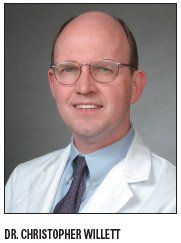Adjuvant bevacizumab/chemo/RT prevents local recurrence in advanced rectal cancer
SAN DIEGO-Bevacizumab (Avastin) added to chemoradiation as neoadjuvant therapy for locally advanced rectal tumors led to substantial downstaging and 100% local control at 4 years in a small phase II study reported at the 2008 American Association of Cancer Research annual meeting (abstract LB-304). The study enrolled 32 patients with T3/T4 nonmetastatic rectal cancer from Massachusetts General Hospital and Duke University Medical Center between 2001 and 2007.
ABSTRACT: Bevacizumab destroys tumor blood vessels, then normalizes the remaining vessels, allowing better delivery of chemotherapy.
SAN DIEGO-Bevacizumab (Avastin) added to chemoradiation as neoadjuvant therapy for locally advanced rectal tumors led to substantial downstaging and 100% local control at 4 years in a small phase II study reported at the 2008 American Association of Cancer Research annual meeting (abstract LB-304). The study enrolled 32 patients with T3/T4 nonmetastatic rectal cancer from Massachusetts General Hospital and Duke University Medical Center between 2001 and 2007.
All patients completed four cycles of neoadjuvant therapy consisting of bevacizumab (5 or 10 mg/kg) on day 1 of each cycle; 5-FU (225 mg/m2) each week of cycles 2 through 4; and external beam irradiation (50.4 Gy in 28 fractions over 5.5 weeks). Surgery was performed 7 to 9 weeks after completion of neoadjuvant therapy. The report was based on the first 25 patients who underwent surgery.
“We observed promising activity and outcomes,” reported Christopher Willett, MD, chief of radiation oncology at Duke. At 4 years, disease-free actuarial survival was 91%, overall survival was 100%; and local control was 100%.
Histologic examination showed no residual cancer in the primary site in 5 patients (20%). In patients with residual disease, histologic findings usually showed microscopic malignant glands embedded in an inflamed and edematous fibrosis. Pathologic T downstaging was seen in 13 of the 25 patients, N down-staging, in 10 of 21 evaluable patients.
Correlative studies
Transcriptional changes in cancer cells were evaluated by quantitative PCR in cells captured from serial biopsies before and after bevacizumab alone.
Bevacizumab alone, and in the combined regimen, was associated with signficantly increased plasma VEGF and placental growth factor (PlGF) levels, compared to baseline. A higher increase in plasma PlGF and VEGF correlated with better outcomes, Dr. Willett reported.
VEGF blockade increased the expression of SDF1 and its receptor CXCR4 in cancer cells (factors linked with angiogenesis, cell migration, and cell survival), but not PlGF or VEGF.
Viable circulating endothelial cells (CECs) and circulating progenitor cells (CPCs) were

significantly decreased by VEGF blockade only at day 3. CEC values in patients with a pathologic complete response were significantly lower than in patients who were T1-2 after treatment.
“The extent of PlGF increase in plasma after bevacizumab, and of VEGF and CECs during combination therapy, as well as the level of CECs before surgery, directly correlated with tumor regression and should be further evaluated,” he said.
Normalization of blood vessels
Co-author Rakesh K. Jain, PhD, of Mass General, said at a press conference that bevacizumab “prunes blood vessels in the tumor, decreases vessel density, and normalizes the remaining blood vessels. This study is the first report to show this happens in humans. Bevacizumab leads to vascular normalization.”
Dr. Jain also commented on the discovery that bevacizumab activates SDF1/CXCR4 expression. “This creates a potential new target to pursue-a candidate beyond VEGF,” he predicted.
Newsletter
Stay up to date on recent advances in the multidisciplinary approach to cancer.